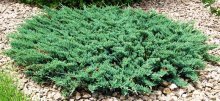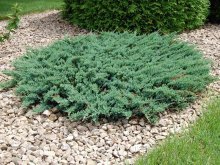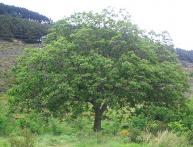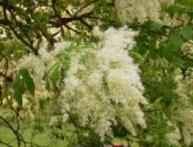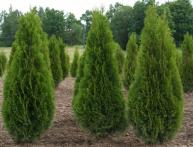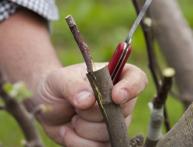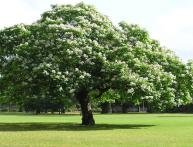Creeping juniper: care, growing tips
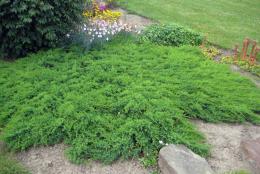
Juniper creeping is a small bush; it can grow no more than 10 centimeters in height. This plant can easily adapt to the soil in which it was planted and can grow even in rocky conditions. Juniper does not lose its appearance both in the sun and in the shade.
Content:
Juniper care
Juniper can grow normally under any conditions. But, nevertheless, he prefers sunny areas. It should be planted in a permanent place in mid-spring or late summer. You should also adhere to the following rules:
- When planting, the rhizome may be damaged. To prevent this from happening, he planted with a lump of soil.
- The width and depth of the hole that is dug for planting will depend on the size of the plant itself and its root system.
- If the soil moisture is high, drainage should be done initially, and then juniper should be planted. Crushed bricks are ideal for this. A layer of up to 20 centimeters is laid.
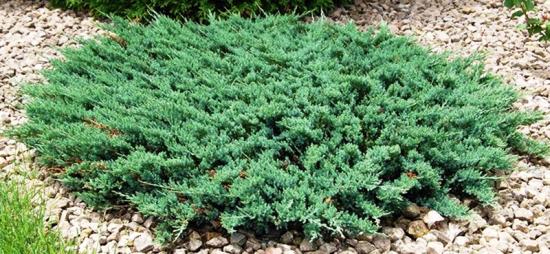
Juniper has no special preference for soil. But it develops well on soil that consists of peat, turf soil and sand. After a certain time, this plant will begin to grow and line the grass carpet. Therefore, you need to take this into account and plant each plant not close to each other. Otherwise, each bush will grow on its neighbor.This will create shadow and the plant will not be able to receive the proper amount of light. After some time, the juniper needs feeding. It is carried out in the spring. For this purpose, fertilizer for coniferous plants is used. One square meter will require 40 grams of this fertilizer.
The juniper that was recently planted needs frequent watering. When the plant grows up, it can easily tolerate drought.
But in extreme heat it is recommended not to forget about watering, spraying will also benefit the plant. It needs to be done in the evening. It is recommended to prepare the soil before planting. First you need to remove all the weeds. Since the plant grows like a carpet, it does not need protection from snow loads. But it is advisable to protect it from the bright sun. In the autumn, the juniper needs to be covered with a green net. If dry branches appear, then they need to be removed. But pruning is not necessary. Owners should ensure that dry leaves do not fall on the needles in the fall. They need to be removed.
Some care tips
Certain conditions must be provided for the juniper to maintain its appearance. In this case, it will develop and grow well. To ensure that the plant always looks beautiful, experienced gardeners advise adhering to the following rules:
- If it gets too hot, cover the plant
- Juniper needs watering and spraying to prevent it from burning
- The plant should be sprayed from a distance, in which case it will not bend from the water.
- A variety of devices are used in winter so that snow does not spoil the appearance of the plant.
- When spring comes, you should do circumcision dry and damaged branches
- Those branches that spoil the appearance are also removed.
- In July the plant should be cut
Juniper should not be planted near the house itself, but at a distance of at least 2 meters
This plant, as already mentioned, easily takes root on any soil. But experienced gardeners recommend using loamy soil for planting. You should also properly plant the bushes not close to each other, since juniper does not like crowded spaces. As soon as planting has taken place, you need to sprinkle the soil with sawdust. After some time, the soil should be loosened. This will benefit the development of juniper.
Plant propagation
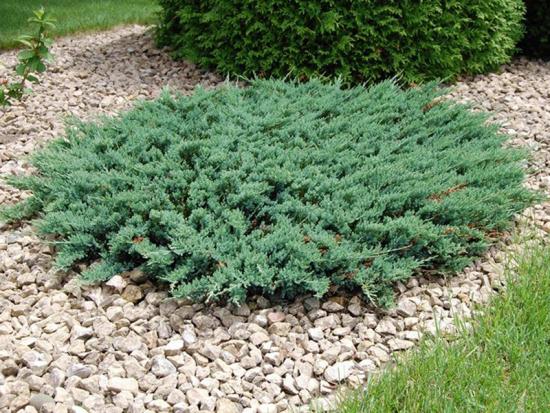
Juniper is a dioecious plant. This means that it can be propagated in two ways, namely vegetatively or using seeds. When the second option is selected, then the decorative properties will not be transferred. For this reason, it is recommended to propagate juniper by cuttings. To do this, you should adhere to the following rules:
- First you need to start cutting the cuttings. To do this, you will need a plant that is already at least 8 years old. Cuttings are pruned in April or May.
- It is recommended to use cuttings that are longer than 10 centimeters.
- From below you need to remove the needles by 5 centimeters.
There should be some old wood left at the end. After this, you need to immerse the cut cuttings in a solution that stimulates growth. It is sold in almost all garden stores. After this, the cutting can be placed in the ground. After this, the seedling should be covered with polyethylene film. It needs to be placed in a dark place. The soil should not dry out, so you need to systematically spray the planted cuttings.
If you provide all the conditions and also take care of the plant, then 1-1.5 months will pass and the first roots will begin to grow. After some time it should be replanted in open ground. stalk. This should be done with the soil in which it grew at the beginning of summer. The plant needs protection from the cold in winter. A variety of devices are used for this. Now it will take time for the juniper to get stronger. After 2-3 years, it can be transplanted to the place that was planned to be chosen for constant growth.
It should be remembered that growing coniferous plants is slightly different from caring for deciduous plants. Even in winter, needles are capable of evaporating moisture. It needs good rhizomes for normal growth. If you follow basic rules, juniper will delight you with its appearance.
Video about creeping juniper:
Interesting information about the vegetable garden

